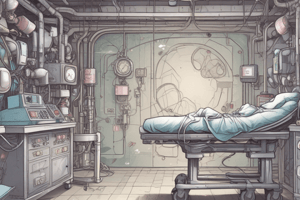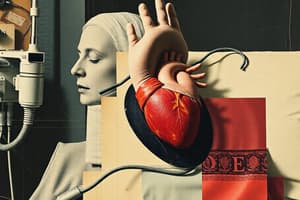Podcast
Questions and Answers
What are the main components of an ECMO circuit?
What are the main components of an ECMO circuit?
- ECMO pump, cannula, heat exchanger, O2 source
- ECMO pump, cannula, oxygenator, heat exchanger (correct)
- ECMO pump, cannula, oxygenator, bubble detector
- ECMO pump, cannula, oxygenator, sweep gas
What is the function of Veno-Venous ECMO (VV ECMO)?
What is the function of Veno-Venous ECMO (VV ECMO)?
- Supports patients with isolated respiratory failure (correct)
- Relies on preserved native cardiac function to maintain cardiac output
- Drains blood from the arterial circulation and returns it to the venous circulation
- Supports patients with cardiac and respiratory failure
What is the primary purpose of Veno-Arterial ECMO (VA ECMO)?
What is the primary purpose of Veno-Arterial ECMO (VA ECMO)?
- Drains blood from the venous circulation and returns it to the arterial circulation
- Relies on preserved native cardiac function to maintain cardiac output
- Supports patients with isolated respiratory failure
- Can be used for cardiac and respiratory support (correct)
What are the other components required for ECMO besides the main circuit components?
What are the other components required for ECMO besides the main circuit components?
What are the types of cannulation for ECMO?
What are the types of cannulation for ECMO?
What is the primary function of ECMO?
What is the primary function of ECMO?
In what way does ECMO help in cases of respiratory infection, heart attack, or trauma?
In what way does ECMO help in cases of respiratory infection, heart attack, or trauma?
What does the process of ECMO involve?
What does the process of ECMO involve?
What is the specific role of ECMO in a person with malfunctioning lungs and heart?
What is the specific role of ECMO in a person with malfunctioning lungs and heart?
What is the purpose of continuously pumping blood out of the body in ECMO?
What is the purpose of continuously pumping blood out of the body in ECMO?
Flashcards
ECMO Circuit Components?
ECMO Circuit Components?
ECMO pump, cannula, oxygenator, heat exchanger
VV ECMO Function?
VV ECMO Function?
Supports patients with isolated respiratory failure.
VA ECMO Purpose?
VA ECMO Purpose?
Cardiac and respiratory support.
Additional ECMO Components?
Additional ECMO Components?
Signup and view all the flashcards
Types of ECMO Cannulation?
Types of ECMO Cannulation?
Signup and view all the flashcards
ECMO Primary Function?
ECMO Primary Function?
Signup and view all the flashcards
How does ECMO help?
How does ECMO help?
Signup and view all the flashcards
What does ECMO involve?
What does ECMO involve?
Signup and view all the flashcards
ECMO's Role?
ECMO's Role?
Signup and view all the flashcards
Purpose of Pumping?
Purpose of Pumping?
Signup and view all the flashcards
Study Notes
ECMO Circuit Components
- The main components of an ECMO circuit include the oxygenator, pump, and cannulae.
Types of ECMO
- Veno-Venous ECMO (VV ECMO) functions to support the lungs, providing oxygenation and removing carbon dioxide.
- Veno-Arterial ECMO (VA ECMO) primarily supports the heart, providing cardiac output and blood pressure.
Additional Components
- Besides the main circuit components, other components required for ECMO include a heat exchanger, a bridge, and a sweep gas source.
Cannulation
- There are two types of cannulation for ECMO: Veno-Venous (VV) and Veno-Arterial (VA).
Primary Function of ECMO
- The primary function of ECMO is to provide both cardiac and respiratory support to patients in cardiac or respiratory failure.
ECMO in Various Situations
- ECMO helps in cases of respiratory infection, heart attack, or trauma by providing temporary support to the lungs and/or heart, allowing them to rest and recover.
ECMO Process
- The ECMO process involves continuously pumping blood out of the body, oxygenating it, and then returning it to the body, bypassing the lungs and/or heart.
ECMO in Specific Situations
- In a person with malfunctioning lungs and heart, ECMO plays a specific role in providing both cardiac and respiratory support, allowing the organs to rest and recover.
Purpose of Blood Pumping
- The purpose of continuously pumping blood out of the body in ECMO is to remove carbon dioxide and add oxygen, thereby maintaining the body's oxygenation and acid-base balance.
Studying That Suits You
Use AI to generate personalized quizzes and flashcards to suit your learning preferences.




